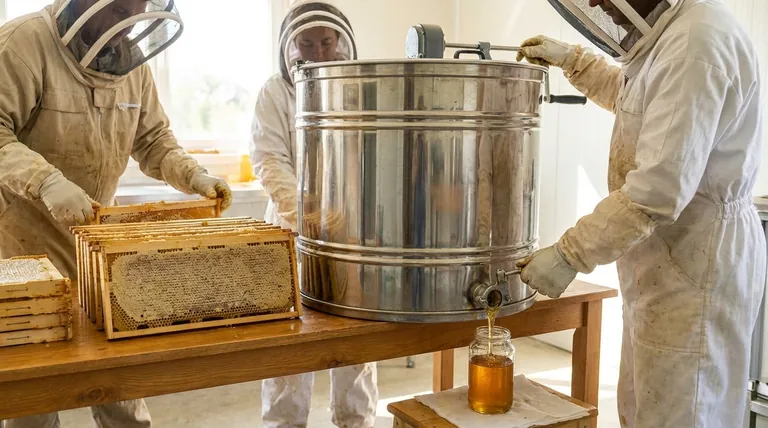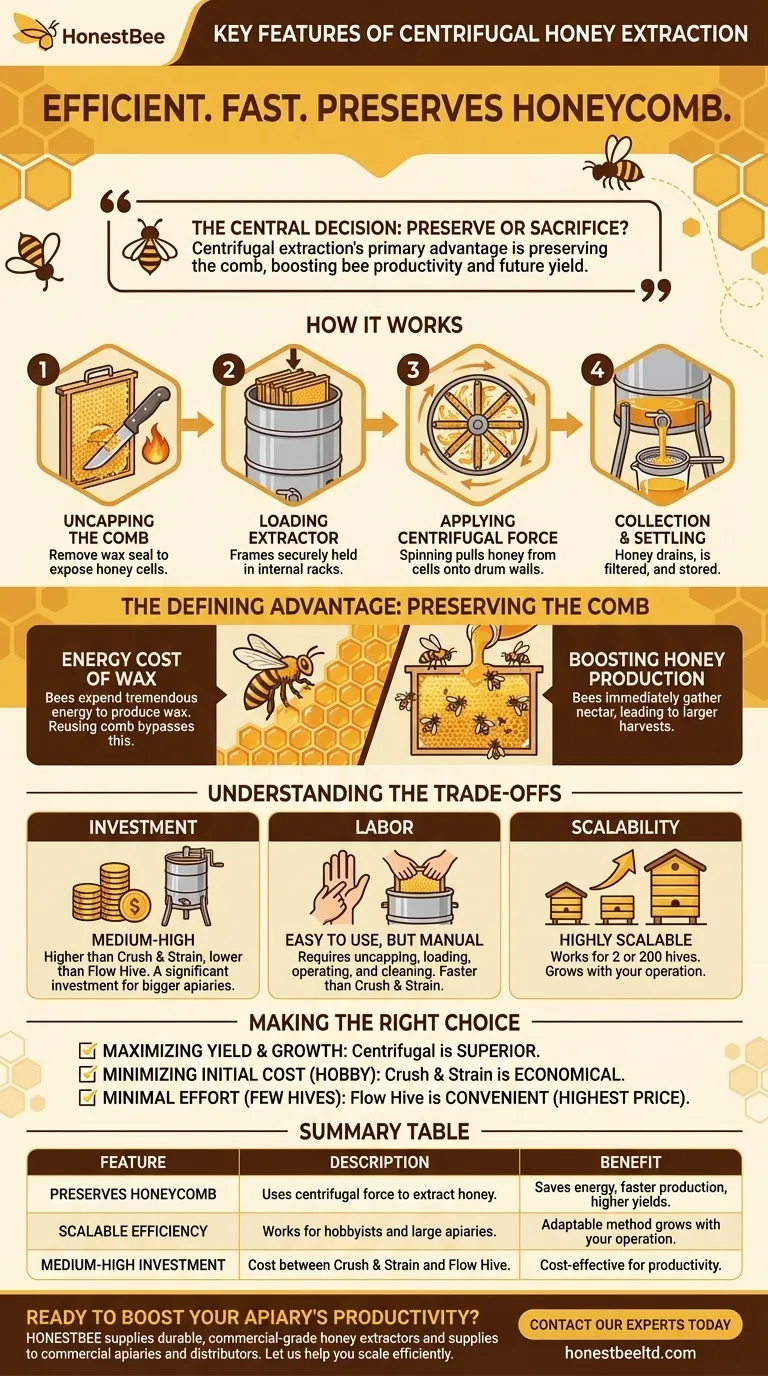At its core, the centrifugal honey extraction method is a highly efficient process defined by its speed and, most importantly, its ability to preserve the honeycomb. It uses spinning force to pull honey from the cells, allowing beekeepers to return the empty, intact frames to the hive for the bees to refill. This method is considered the standard for most beekeepers, from hobbyists to large commercial operations.
The central decision in honey extraction is whether to preserve or sacrifice the honeycomb. Centrifugal extraction's primary advantage is that it preserves the comb, which significantly boosts your bees' productivity and the following season's honey yield.

How Centrifugal Extraction Works
The process is a well-established mechanical system that prioritizes a clean separation of honey from the wax comb. It relies on simple physics and can be performed with either a manual hand-crank or an electric motor.
Step 1: Uncapping the Comb
Before extraction, the wax cappings that seal the honey-filled cells must be removed. Beekeepers use a specialized tool, like a heated knife or an uncapping fork, to slice off this thin top layer of wax.
Step 2: Loading the Extractor
The uncapped frames are then placed vertically inside a large drum, which is the honey extractor. These extractors are designed with internal racks to hold multiple frames securely in place.
Step 3: Applying Centrifugal Force
The extractor is activated, spinning the frames rapidly. This rotation generates centrifugal force, which flings the honey outwards from the cells and onto the inner wall of the drum.
Step 4: Collection and Settling
The extracted honey slides down the extractor's walls and pools at the bottom. It is then drained through a spigot, often passing through a sieve or filter to remove any remaining wax particles or debris before being moved to a storage container.
The Defining Advantage: Preserving the Comb
The single most important feature of centrifugal extraction is that it leaves the delicate beeswax comb almost entirely intact. This is a critical factor for the health and productivity of a bee colony.
The Energy Cost of Wax
Bees expend a tremendous amount of energy to produce wax and construct comb. By reusing the existing comb, the colony can bypass this energy-intensive step entirely.
Boosting Honey Production
When frames are returned, the bees can immediately begin gathering nectar and refilling the cells with honey. This directly translates to a much larger honey harvest in the next cycle compared to methods where the bees must rebuild the comb from scratch.
Understanding the Trade-offs
While it is the industry standard, the centrifugal method involves specific considerations regarding cost, labor, and equipment. It is not a one-size-fits-all solution.
The Initial Investment
The cost is categorized as medium to high. A small, manual extractor is a manageable expense for a hobbyist, but larger, electric models required for bigger apiaries represent a significant financial investment. This cost is higher than the low-cost Crush & Strain method but generally less than a premium system like a Flow Hive.
The Labor Involved
Though considered easy to use, the process is not automated. It requires the manual steps of uncapping frames, loading and unloading the extractor, operating the machine, and cleaning all the equipment afterward. It is faster than Crush & Strain but more hands-on than the "instant" extraction of a Flow Hive.
Scalability vs. Other Methods
This method's key strength is its scalability. The same principle works for a beekeeper with two hives or two hundred. In contrast, Crush & Strain is difficult to manage at scale due to its slow speed, and Flow Hives are primarily designed for the small-scale hobbyist.
Making the Right Choice for Your Apiary
Your decision should be based on your specific goals, the size of your operation, and your budget.
- If your primary focus is maximizing honey yield and long-term growth: Centrifugal extraction is the superior choice because preserving the comb is the fastest way to increase production.
- If your primary focus is minimizing initial costs for a new hobby: The Crush & Strain method is the most economical entry point, but accept that your bees will have to rebuild the comb.
- If your primary focus is convenience and a minimal-effort experience for a few hives: A Flow Hive is designed for this purpose, though it comes at the highest price point.
Ultimately, choosing centrifugal extraction is an investment in your apiary's long-term productivity and efficiency.
Summary Table:
| Key Feature | Description | Benefit |
|---|---|---|
| Preserves Honeycomb | Uses centrifugal force to extract honey without destroying the wax cells. | Saves bees energy, leading to faster honey production and higher yields. |
| Scalable Efficiency | Works for both hobbyists and large commercial apiaries with manual or electric models. | A single, adaptable method that grows with your operation. |
| Medium-High Investment | Higher initial cost than crush & strain, but generally lower than Flow Hive systems. | A cost-effective investment for serious beekeepers focused on productivity. |
Ready to Boost Your Apiary's Productivity?
Investing in the right centrifugal extraction equipment is key to maximizing your honey yield and supporting your bee colony's health. HONESTBEE supplies durable, commercial-grade honey extractors and beekeeping supplies to commercial apiaries and distributors through our wholesale-focused operations.
Let us help you scale your operation efficiently. Contact our experts today to discuss your needs and get a quote!
Visual Guide

Related Products
- HONESTBEE 72 Frame Industrial Electric Honey Extractor for Beekeeping
- electric honey extractor honey centrifuge 3 frame honey extractor stainless steel honey frame extractor
- 2 Frame Stainless Steel Manual Honey Spinner Extractor for Beekeeping
- 40 Frame Commercial Electric Honey Extractor for Beekeeping
- Commercial Electric 12 Frame Honey Extractor Spinner Motorized Honey Extractor
People Also Ask
- How is honey harvested from Langstroth hives? A Guide to Efficient, Comb-Preserving Extraction
- Why is preserving honeycomb integrity important, and how do automated extractors help? Boost Hive Health & Honey Yields
- Why do beekeepers have to lift a lot of weight at the end of a growing season? The Reward of a Heavy Harvest
- What should a beekeeper do after extracting honey from supers? A Guide to Harvest Management
- What are the advantages of automated honey extractors in terms of time efficiency? Boost Your Harvest Speed



















